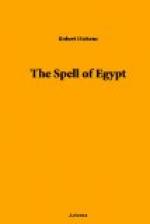From Abydos, home of the cult of Osiris, Judge of the Dead, I came to Denderah, the great temple of the “Lady of the Underworld,” as the goddess Hathor was sometimes called, though she was usually worshipped as the Egyptian Aphrodite, goddess of joy, goddess of love and loveliness. It was early morning when I went ashore. The sun was above the eastern hills, and a boy, clad in a rope of plaited grass, sent me half shyly the greeting, “May your day be happy!”
Youth is, perhaps, the most divine of all the gifts of the gods, as those who wore the lotus-blossom amulet believed thousands of years ago, and Denderah, appropriately, is a very young Egyptian temple, probably, indeed, the youngest of all the temples on the Nile. Its youthfulness—it is only about two thousand years of age—identifies it happily with the happiness and beauty of its presiding deity, and as I rode toward it on the canal-bank in the young freshness of the morning, I thought of the goddess Safekh and of the sacred Persea-tree. When Safekh inscribed upon a leaf of the Persea-tree the name of king or conqueror, he gained everlasting life. Was it the life of youth? An everlasting life of middle age might be a doubtful benefit. And then mentally I added, “unless one lived in Egypt.” For here the years drop from one, and every golden hour brings to one surely another drop of the wondrous essence that sets time at defiance and charms sad thoughts away.
Unlike White Abydos, White Denderah stands apart from habitations, in a still solitude upon a blackened mound. From far off I saw the facade, large, bare, and sober, rising, in a nakedness as complete as that of Aphrodite rising from the wave, out of the plain of brown, alluvial soil that was broken here and there by a sharp green of growing things. There was something of sadness in the scene, and again I thought of Hathor as the “Lady of the Underworld,” some deep-eyed being, with a pale brow, hair like the night, and yearning, wistful hands stretched out in supplication. There was a hush upon this place. The loud and vehement cry of the shadoof-man died away. The sakieh droned in my ears no more like distant Sicilian pipes playing at Natale. I felt a breath from the desert. And, indeed, the desert was near—that realistic desert which suggests to the traveller approaches to the sea, so that beyond each pallid dune, as he draws near it, he half expects to hear the lapping of the waves. Presently, when, having ascended that marvellous staircase of the New Year, walking in procession with the priests upon its walls toward the rays of Ra, I came out upon the temple roof, and looked upon the desert—upon sheeny sands, almost like slopes of satin shining in the sun, upon paler sands in the distance, holding an Arab campo santo, in which rose the little creamy cupolas of a sheikh’s tomb, surrounded by a creamy wall, those little cupolas gave to me a feeling of the real, the irresistible Africa such as I had not known since I had been in Egypt; and I thought I heard in the distance the ceaseless hum of praying and praising voices.




